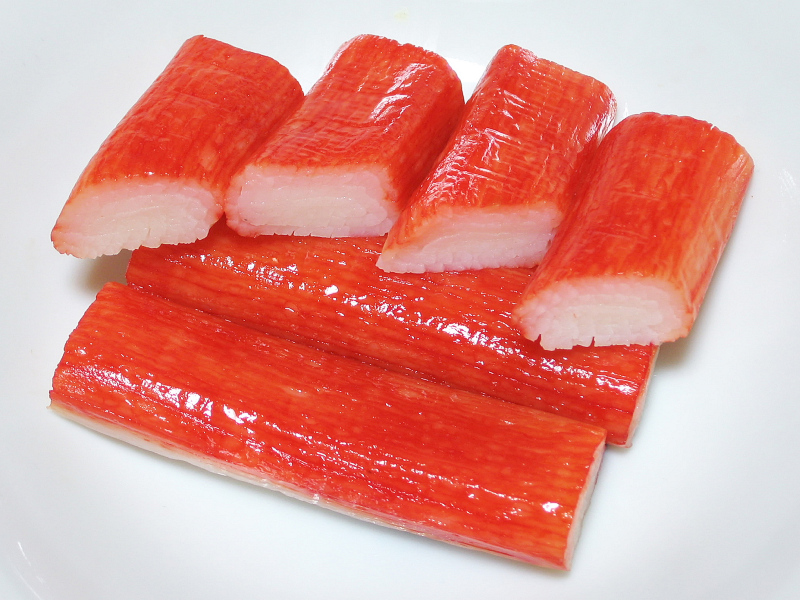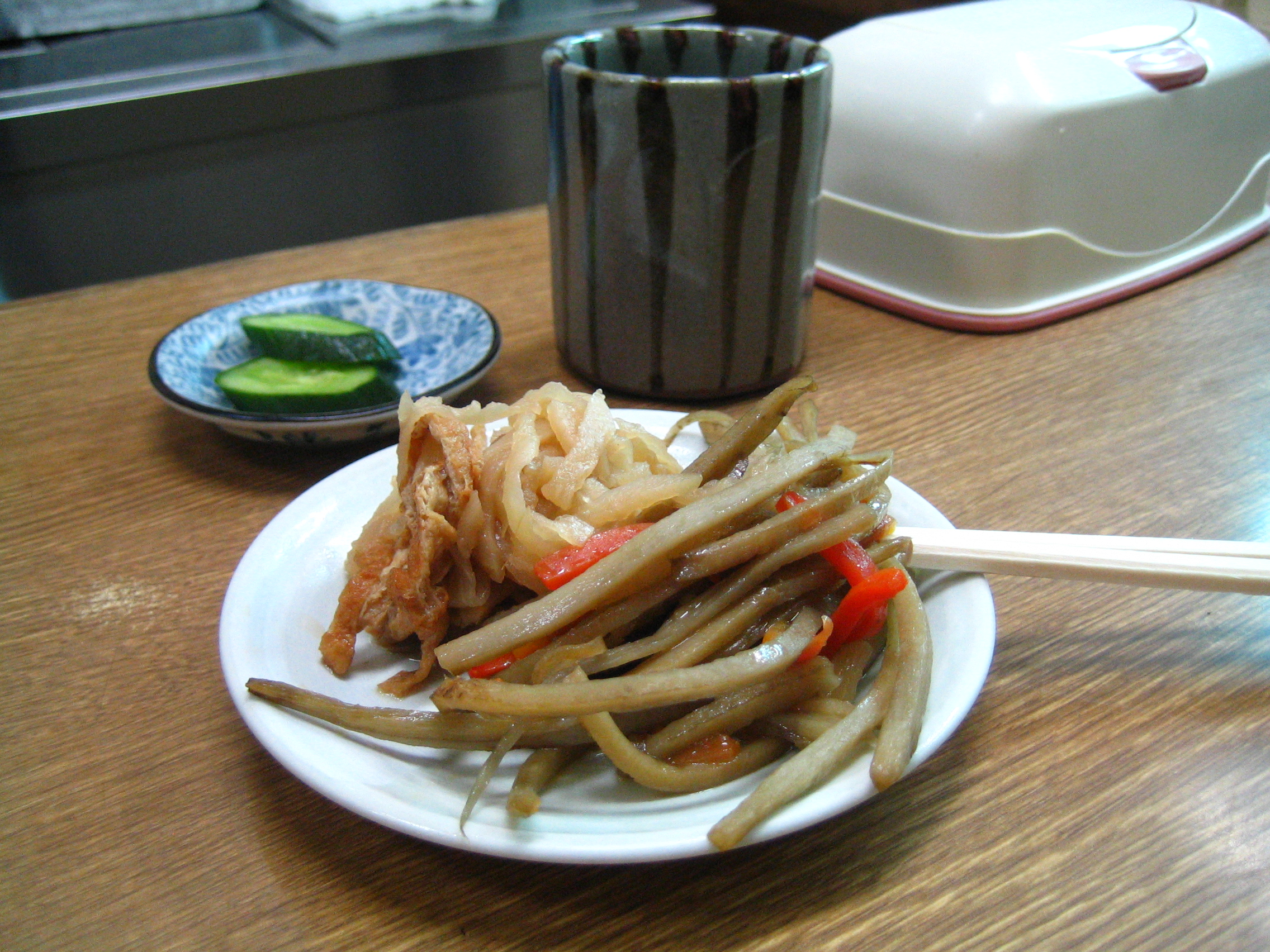|
Satsumaage
is a fried fishcake originating from Kagoshima, Japan. Surimi and flour are mixed to make a compact paste that is solidified through frying. It is a specialty of the Satsuma region. It is known by a variety of regional names throughout Japan. The paste is made from fish and seasoned with salt, sugar, and other spices and molded into several shapes. It is made not only from ground fish but can include wood ear, beni shōga, onion, Welsh onion and other vegetables, squid, octopus, shrimp and other seafood, and spices. In fishing villages, it is made from local fish, such as sardines, shark, bonito or mackerel. It is often made by mixing two or more kinds of fish. People eat satsuma-age plain or lightly roasted and dipped in ginger and soy sauce or mustard and soy sauce. It is used in oden, udon, sara udon or nimono (stewed dishes). Composition Commonly Satsuma-age used cod as a filling; however, as cod stocks have been depleted other varieties of white fish are used, such ... [...More Info...] [...Related Items...] OR: [Wikipedia] [Google] [Baidu] |
Surimi
is a paste made from Fish as food, fish or other meat. It can also be any of a number of East Asian cuisine, East Asian foods that use that paste as their primary ingredient. It is available in many shapes, forms, and textures, and is often used to mimic the texture and color of the meat of Lobster meat, lobster, Crab meat, crab, grilled Japanese eel, or shellfish. History Fish pastes have been a popular food in East Asia. In China, the food is used to make fish balls (魚蛋/魚丸) and ingredients in a thick soup known as ''Geng (dish), geng'' (羹), common in Fujian cuisine. In Japan, the earliest surimi production was in 1115 for making ''kamaboko''. Alaska pollock, native to the seas around Japan, played an important role in the development of processed surimi due to its high protein biomass. Satsumaage, chikuwa, and hanpen were other major surimi foods prior to 1960. After World War II, machines were used to process surimi, but it was always sold fresh, since freezing ... [...More Info...] [...Related Items...] OR: [Wikipedia] [Google] [Baidu] |
Fishcake
A fishcake (sometimes written as fish cake) is a culinary dish consisting of filleted fish or other seafood minced or ground, mixed with a starchy ingredient, and fried until golden. Asian-style fishcakes usually contain fish with salt, water, starch, and egg. They can include a combination of fish paste and surimi. European-style fishcakes are similar to a croquette, consisting of filleted fish or other seafood with potato patty, sometimes coated in breadcrumbs or Batter (cooking), batter. Fishcakes as defined in the ''Oxford Dictionary of Food and Nutrition'' are chopped or minced fish mixed with potato, egg and flour with seasonings of onions, peppers and sometimes herbs. The fishcake has been seen as a way of using up leftovers that might otherwise be thrown away. In Mrs Beeton's 19th century publication ''Mrs Beeton's Book of Household Management, Book of Household Management'', her recipe for fishcakes calls for "leftover fish" and "cold potatoes". More modern recipes have ... [...More Info...] [...Related Items...] OR: [Wikipedia] [Google] [Baidu] |
:Category:Japanese Words And Phrases ...
{{Commons Words and phrases by language Words Words Words A word is a basic element of language that carries meaning, can be used on its own, and is uninterruptible. Despite the fact that language speakers often have an intuitive grasp of what a word is, there is no consensus among linguists on its ... [...More Info...] [...Related Items...] OR: [Wikipedia] [Google] [Baidu] |
Whitefish (fisheries Term)
Whitefish or white fish is a fisheries term for several species of demersal fish with fins, particularly Atlantic cod (''Gadus morhua''), whiting (fish), whiting (''Merluccius bilinearis''), haddock (''Melanogrammus aeglefinus''), Phycidae, hake (''Urophycis''), and pollock (''Pollachius''), among others. Whitefish live on or near the seafloor, and can be contrasted with the Oily fish, oily or pelagic fish, which live away from the seafloor. Whitefish do not have much fish oil, oil in their tissue, and have flakier white or light-coloured flesh. Most of the oil found in their bodies is concentrated in the organs, e.g. cod liver oil. Whitefish can be divided into benthopelagic fish (round fish that live ''near'' the sea bed, such as cod and Coley (fish), coley) and benthic fish (which live ''on'' the sea bed, such as flatfish like plaice). Whitefish is sometimes eaten straight but is often used reconstituted for fishsticks, gefilte fish, lutefisk, surimi (imitation crab meat), e ... [...More Info...] [...Related Items...] OR: [Wikipedia] [Google] [Baidu] |
Nimono
is a simmered dish in Japanese cuisine. A nimono generally consists of a base ingredient simmered in ''shiru'' stock and seasoned with sake, soy sauce, and a small amount of sweetening. The nimono is simmered in the shiru over a period of time until the liquid is absorbed into the base ingredient or evaporated. The base ingredient for a nimono is typically a vegetable, fish, seafood, or tofu, or some combination of these. The ''shiru'' stock for a nimono is generally dashi. Other than sake and soy sauce, the stock can be further flavored with mirin, sugar, salt, vinegar, miso, or other condiments. Types 235px, Boiled seaperch with ginger, soy sauce, mirin, sugar, sake, and water. * , also : fish, but sometimes vegetables, simmered in a mixture of miso and dashi * : beef and potato stew, flavoured with sweet soy * : fish poached in a broth of sweetened dashi, sometimes with miso, also referred to as . The dish first appears in cookbooks in the early 18th century * : chunks of ... [...More Info...] [...Related Items...] OR: [Wikipedia] [Google] [Baidu] |
Burdock Satsumaage
''Arctium'' is a genus of biennial plants commonly known as burdock, family Asteraceae. Native to Europe and Asia, several species have been widely introduced worldwide. Burdock's clinging properties, in addition to providing an excellent mechanism for seed dispersal, led to the invention of the hook and loop fastener. Description Plants of the genus ''Arctium'' have dark green leaves that can grow up to long. They are generally large, coarse, and ovate, with the lower ones being heart-shaped. They are woolly underneath. The leafstalks are generally hollow. ''Arctium'' species generally flower from July through October. Burdock flowers provide essential pollen and nectar for honeybees around August, when clover is on the wane and before the goldenrod starts to bloom. Burdock's clinging properties make it an excellent mechanism for seed dispersal. Taxonomy A large number of species have been placed in genus ''Arctium'' at one time or another, but most of them are now classi ... [...More Info...] [...Related Items...] OR: [Wikipedia] [Google] [Baidu] |
Cod As Food
Cod and other cod-like fish have been widely used as food through history. Other cod-like fish come from the same family (Gadidae) that cod belong to, such as haddock, pollock, and Merlangius, whiting. Cod Cod is popular as a food with a mild flavour and a dense, flaky Whitefish (fisheries term), white flesh. Young Atlantic cod or haddock prepared in strips for cooking is called scrod. Cod's soft liver can be canned or fermented into cod liver oil, providing an excellent source of vitamin A, vitamin D, vitamin E and omega-3 fatty acids (eicosapentaenoic acid, EPA and docosahexaenoic acid, DHA). Cod flesh is moist and flaky when cooked and is white in colour. In the United Kingdom, Atlantic cod is one of the most common ingredients in fish and chips, along with haddock and plaice. Cod can be easily turned into various other products, such as cod liver oil, omega pills, etc. According to the laws of kashrut, cod is considered kosher because it is a Kosher fish, fish with both fins ... [...More Info...] [...Related Items...] OR: [Wikipedia] [Google] [Baidu] |
Oily Fish
Oily fish are fish species with fish oil, oil (fats) in soft tissues and in the coelomic cavity around the Gut (zoology), gut. Their fillet (cut), fillets may contain up to 30% oil, although this figure varies both within and between species. Examples of oily fish include small forage fish such as sardines, herring and anchovy, anchovies, and other larger pelagic fish such as salmon, trout, tuna, swordfish and mackerel. Oily fish can be contrasted with whitefish (fisheries term), whitefish, which contain oil only in the liver and in much less overall quantity than oily fish. Examples of whitefish are cod, haddock and flatfish. White fish are usually demersal fish which live on or near the seafloor, whereas oily fish are pelagic, living in the water column goes from the bottom. Oily Fish as food, fish meat is a good source of important lipophilicity, fat-soluble vitamins such as Vitamin A and Vitamin D, D, and is rich in omega-3 fatty acids (white fish also contain these nu ... [...More Info...] [...Related Items...] OR: [Wikipedia] [Google] [Baidu] |
Haddock
The haddock (''Melanogrammus aeglefinus'') is a saltwater ray-finned fish from the Family (biology), family Gadidae, the true cods. It is the only species in the Monotypy, monotypic genus ''Melanogrammus''. It is found in the North Atlantic Ocean and associated seas, where it is an important species for fisheries, especially in northern Europe, where it is marketed fresh, frozen and Smoked fish, smoked; smoked varieties include the Finnan haddie and the Arbroath smokie. Other smoked versions include long boneless, the fileted side of larger haddock smoked in oak chips with the skin left on the fillet. Description The haddock has the elongated, tapering body shape typical of members of the cod family. It has a relatively small mouth which does not extend to below the eye; with the lower profile of the face being straight and the upper profile slightly rounded, this gives its snout a characteristic wedge-shaped profile. The upper jaw projects beyond the lower more so than in th ... [...More Info...] [...Related Items...] OR: [Wikipedia] [Google] [Baidu] |







